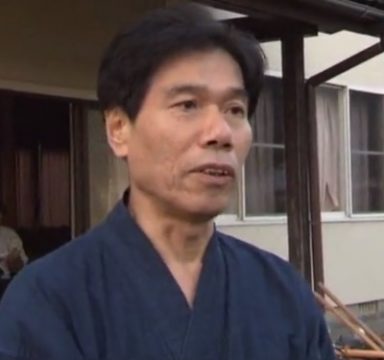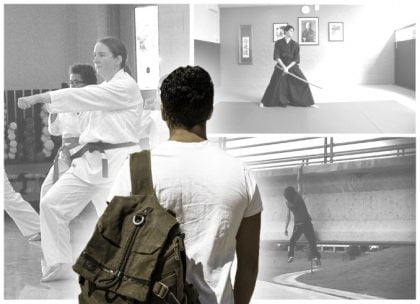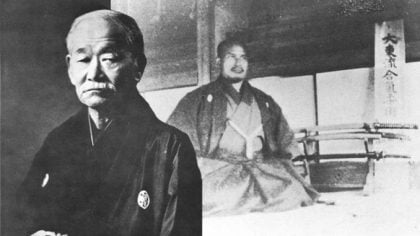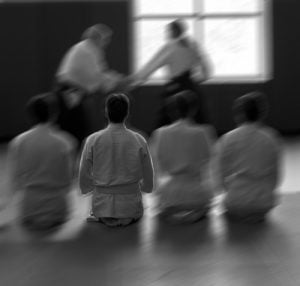How do ninjutsu techniques actually look like? They aren’t exactly martial art moves, but stealth techniques.
COOL JAPAN visits Banke Shinobinoden’s training grounds to capture some ninjutsu moves on video. See each ninjutsu technique in action in the list below. And watch the entire show at the end.
What is Banke Shinobinoden?
Banke Shinobinoden is a ninjutsu school located at Kaizuten Shrine in Shiga prefecture, whose soke is Jinichi Kawakami. He is one of four people commonly thought to be the last modern ninja.
Even though Banke Shinobinoden’s historical lineage cannot be independently verified (like every other ninjutsu school today), Jinichi Kawakami is an expert on the subject whose knowledge is consistent to actual historical sources. Furthermore, he is a historical ninjutsu researcher and lecturer at Mie University, Japan, and a director of the official Iga Ninja Museum.

But why the interest in Banke Shinobinoden’s ninjutsu techniques?
Two reasons. First, compared to Bujinkan, not many people know the actual techniques taught by Banke Shinobinoden. Second, the focus of their syllabus is a point of curiousity; where most ninjutsu schools today focus mostly on martial arts, Banke Shinobinoden’s syllabus seems to have equal emphasis on both shinobi-no-jutsu and martial arts.
Note: Because COOL JAPAN’s ninja episode focuses on foreigner perspectives, the training footage captured are of students from Europe visiting the dojo. Apparently, these students travel to Japan yearly to undergo one week of training. They then write down the details of every technique they’ve trained in, so that they can replicate the training back in their home countries.
Banke Shinobinoden Ninjutsu Techniques
Banke Shinobinoden breaks down ninja techniques into the following categories, which they state is necessary to conduct espionage missions:
- Martial arts – traditional empty-hand techniques and weapon techniques (sword, shuriken and others)
- Information gathering – disguise, psychology, invasion and others
- Pharmacy – poison, medical treatment, gunpowder manufacturing and others
- Art for amusement – traditional arts, acrobatics and others
Warm Up and Conditioning Drills
It is evident from the training footage that Banke Shinobinoden takes conditioning against weakness, pain and sudden attacks seriously.
Crawling and jumping on all fours

Shinobi sometimes crawled to make themselves less visible to the enemy. This conditioning exercise trains their agility and swiftness when crawling or jumping on all fours in all directions – back, forward, left and right.
The warm up supposedly last for nearly an hour.
Strengthening weak body parts

The shinobi conditioned weak body parts such as their fingers by smacking down on them continuously. It helps with getting used to the pain and strengthening the body part.
This is no different from traditional Muay Boran fighters who kick trees to condition their shins. Or street calisthenics practitioners who form calluses from constant bar work (i.e. pull ups, muscle ups and more).
Condition body to deal with sudden strangulation

Being ambushed from the back and strangled must have been common. Based on my understanding, hitting the throat could condition a reflex that helped the shinobi deal with sudden strangulation.
Secret techniques of the ninja – Uzuragakure

Uzuragakure involves distraction and illusion.
- Light the gunpowder concoction – the sudden flare of light and smoke blinds the enemy temporarily.
- Quickly crouch down, make yourself appear small and cover yourself with a dark cloak – in the dark you will look like a rock formation.
- Do not move even when tired or accidentally kicked
Iga ninja supposedly disappeared from plain sight by imitating rocks in the surroundings. Obviously, this technique works better when it’s dark.
Use of Unconventional Weapons & Fighting Tactics
Historical sources reveal that ninjutsu was not a martial art. But how did the shinobi deal with combat, when forced to fight. Banke Shinobinoden’s techniques gives some insight on how ninjas fought:
- Unconventional tactics – weapons would be used in unpredictable ways that the enemy were not used to, thereby giving the shinobi the advantage. This includes improvising weapons to confuse and overwhelm the attacker (e.g. bamboo with lead ball).
- Distraction tactics – often times common tools and objects were used to distract rather than to maim.
- Use of common objects in their surroundings – historical sources suggest that ninja did not carry special weapons that would expose their identity. Using common items in a fight makes sense.
- Running away – according to Jinichi Kawakami, shinobi sought to minimise the cost of fighting; this essentially means fleeing when possible (or setting up a fight that makes fleeing easier).
To dodge a katana slash and roll away

Lead Ball attached to Bamboo

Using gardening shears

Using Kimono Obi


Using metal rings to distract

Cool Japan – Ninja Episode (Visit to Banke Shinobinoden)
Cool Japan’s ninja episode explores the ninja from a foreigner’s perspective. It features places in Japan to get your ninja experience and talks about how ninja manga and anime influenced pop culture.
If you have no time to watch the whole show below, the 7-minute segment on Banke Shinobinoden begins at 17:17 and ends at 24:50.
Source: COOL JAPAN – Ninja & Banke Shinobi Spain




